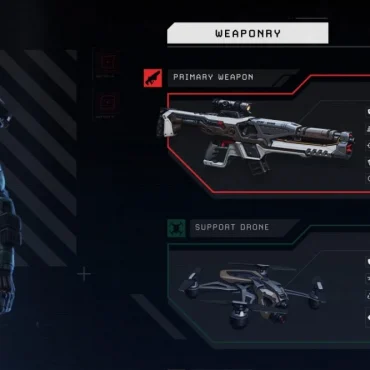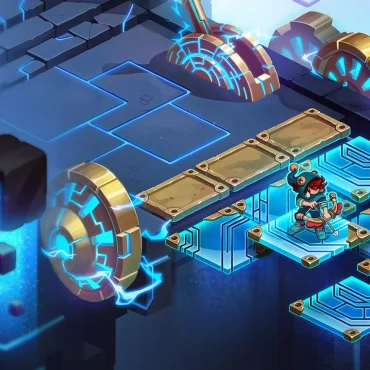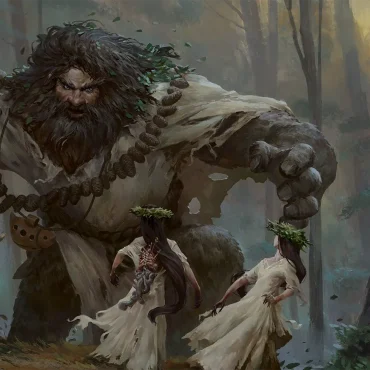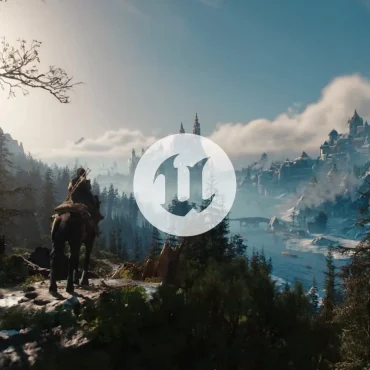Paradox Interactive and N-iX Game & VR Studio have been partners since 2017. Our team has contributed to most of their projects and DLCs since then, including such games as Stellaris, Crusader Kings III, Imperator: Rome, Europa Universalis IV, Hearts of Iron IV, etc.
Since it’ll be our 5th anniversary of cooperation with Paradox Interactive in just a month, we decided to conduct an interview with Anton Wittberg Letoff, Art Manager & Producer at Paradox Development Studio. Here we talk about Anton’s experience at the company, how our cooperation started, COVID and the new Obi-Wan series, the importance of establishing trust and communication, meatballs, challenges of art production and how we overcame them, Anton’s favorite games, and so much more.
Who is Who
- Anton Wittberg Letoff: Art Manager & Producer – was in charge of all outsourcing content and now holds Stellaris on his shoulders. Also, a true Swede who loves meatballs in good company.
- Daniel Poludyonny: Head of Game & VR Studio – has been here since the start of our cooperation with Paradox, so he probably knows what he’s talking about.
- Veronika Chebotarova: Marketing Manager – resorts to nostalgia, one of the deadliest weapons, by bringing up images from the archives.
- Arthur Tereshchuk: Content Writer – sits there, listens carefully, and smiles awkwardly. Also writes this text.
If you are a reader-type person, here’s a bit shortened text version of the interview:
Anton’s Experience at Paradox, Sanity, and Start of Our Cooperation
Daniel: I pulled up our very first agreement today to have a look at the date, and in just about a month, on the 22nd of July, it’s gonna be five years since we signed it. So I wanted to start with a little bit of intro about how we started working with Paradox. It was a very small assignment, I think it was for Titans – Stellaris’ DLC, and we produced only five ships. Back then there was Pernilla Sparrhult, who was in charge of the outsourcing. Then we’ve done another, bigger assignment in late 2017. After she left, Adrian joined, and he was the only one from the outsourcing team. I remember, in January, we were talking about how stuff should be done as we were working on Stellaris, and that’s when you joined. It was January or February 2018. Is that right?
Anton: I actually joined a bit later. A week ago I had my four-year anniversary. So I joined in June 2018.
Daniel: How would you describe your experience joining the outsourcing team? What were you doing before and how did you like it at Paradox?
Anton: I came from DICE, I worked on Battlefront 2 as a project assistant. And then I applied as a Junior Art Producer at Paradox and I got it. This was a while ago so I don’t remember all the details, but in the beginning, since I was alone as well, there was a lot of firefighting. You know, putting out fires to solve the immediate crisis. And apart from all that, I was taking care of all outsourcing content for our games. It was everything from Imperator to Stellaris and Hearts of Iron and all of that. I did a lot of outsourcing administration to make sure everything got submitted and to make sure people were talking to each other. All the usual stuff, but it was on a different scale since I took care of all kinds of projects.
Daniel: I actually wanted to show you some ancient artifacts that we dug out. This is the image of one of the first ships that we produced.

Veronika: We just decided to add a touch of nostalgia to our meeting.
Anton: That’s a great spice, right? You want to have a bit of nostalgia in everything.
Daniel: So this was the first ship, and then later in fall 2018 I think I convinced you guys that I need to come over and we need to hang out together. We actually had a great time with you guys, with you and Adrian. Here’s the photo from back then. There were just the two of you, so I imagine how difficult it was to manage all the projects. At that time we only did the 3D part for Stellaris, but I think at some point we started also working with species design and so on. Do you remember anything about it?

Anton: Unfortunately, I don’t. In the beginning, it was a lot for me to just make sure all the administrative stuff was handled the right way, to keep track of everything all of that. So, I don’t remember all the details. I do remember, however, us internally talking about giving you guys more responsibility and handing over more things to you. That was kind of a big thing because we hadn’t done it that way before. So I remember that in this context.
Daniel: So let’s stay in 2018. You said that you had to work on all those projects: you mentioned Imperator: Rome, which was in development in 2018, Hearts of Iron 4, and I remember us working on Europa back then. How did you manage to maintain sanity with all that?
Anton: To be honest, I don’t think I did. This was my first producer kind of job in the industry and I didn’t really know what to expect. So I just went into it without knowing anything and learned all on the go. I took everything that I could take because I wanted to learn. Towards the end of 2018, we started to see that it was getting too much, and at the beginning of 2019, we extended the team with two new people. So it was not only me doing the art production at PDS.
Daniel: I remember that in 2019 it was so exciting to work on the new title – Imperator: Rome. It was something that we haven’t done before, we only worked with you guys on DLCs, and I believe everybody loved that. I’m not sure what happened with Imperator: Rome. Do you think there is a future to this game?
Anton: I’m not sure. In my personal opinion and not the company’s opinion, I think that it was kind of a niche game with a very specific time and setting. I think that we can do so much more with our elder titles, and we should focus on them instead.
Offline Meetings, Trust, and Meatballs
Daniel: I wanted to maintain this good tradition of meeting you guys. We had a broader meeting in late 2019 when I brought our lead artists. We also have a photo from this meeting. You can see that Adrian slimmed quite a lot, probably because of the stressful work, and here are Melinda and Philip. And I think that right now the team is bigger than ever. Do you remember this session? I think we spent the whole day having meetings with your lead artists, doing postmortems and recaps, remembering everything that was good or bad, and how we can improve stuff.

Anton: I remember this a lot more clearer than the first one. I think that this was just when we had moved into the new office. As you mentioned, we had a bunch of postmortems and syncs with our artists. We talked a lot about how the year has been, what we could potentially do in the future, giving each other feedback and talking about how we gonna improve on things. We had a pretty specific agenda and a list of things to talk about so that we’re getting a result. And I think that was super successful.
Daniel: Do you think that this type of routine that you’ve done annually is useful for the cooperation between the teams?
Anton: Yeah, definitely. And it doesn’t matter if these are two different studios coming together or if it’s me and my colleagues sitting here in the office. I think that in order to have a good collaboration, you need to have a foundation of trust by getting to know each other a bit more, not only via Google Meet or Zoom or whatever. I think that you gain that a lot by just meeting each other and going out for meatballs together and all of that. I think that that’s a big thing and a bit underrated as well.
Challenges, Art, and Challenges Caused by Art
Daniel: Do you remember any challenges during our cooperation? Maybe there were some grinding gears at the beginning, when our teams tried to understand each other and what one wants. And how do you think we managed to overcome these challenges?
Anton: I don’t have many examples, I wanna just give that as a disclaimer, but I have a couple of things that are on the subject. In the beginning, during the very first work that we did together, I can’t remember which one it was, maybe Necroids, there were a lot of growing pains. We had a set process that we thought was correct and that one should follow. Then we had our first call, where we could talk instead of sending emails back and forth, listing problems, like “this model is wrong in this way, this needs a bit of tweaking”. And when we introduced those Friday weekly syncs we could prepare for, a lot of those things went away. We had 30 minutes that we could just: “all right, let’s talk about these things. Let’s improve on this. Let’s do this instead. Let’s do that instead.” And that was one of those things where communication was key.
When you’re getting into a meeting, you’re leaving your ego out the door. It doesn’t matter if you are Lead 3D Artist, if you’re a senior or junior person, you’re leaving your ego there out the door, and then you give each other feedback.
I think that both of us were very good at that, to sort of drop our seniority, drop our experience level, and just talk to each other.
That was the first thing. The second thing that I think opened new eyes to me was when we were working on expansions, it could be Nemesis, and we gave you the opportunity to implement the work that you’ve made to the actual game. Because you had brought it up, you you’ve talked about this. I think it was Sergey [Sergii Gotsman, Project Manager] who had an idea. He was like: “what if we do that on our end, instead of us sending you the finished model and you would do that.”
That was brought up, we talked about it, and we realized that this is a problem that we can solve very easily. We can just give that responsibility to you guys. And that’s another very clear example on how our partnership has been developing in a positive way.
Arthur: Was this experience from the cooperation between our teams and developing new frameworks useful for Paradox when coopering with other art outsourcing vendors?
Anton: Oh yeah, definitely. I was talking about before that it doesn’t matter if you are a studio working with an outsourcing partner or if I am a manager and I’m talking to my colleagues – as soon as you’re working with people, you want to use the best processes possible. So if you identify a problem that could be solved very easily, as in this example, it’s obvious that I’m gonna use it in my next process because it’s helped us a lot.
The same goes internally: if one of my concept artists sees that we can improve how we’re making concepts, then I’m gonna take that and ask my other concept artists to do the same thing. But I also think that in order for you to be able to come to that stage and feel comfortable with suggesting, it’s super important that you trust each other. Especially in this case, in order for Sergey to get to a stage where he felt comfortable bringing that up, there must be an established relationship. Sergey knew that when he was suggesting this, we were not gonna curse him out. We’re not gonna yell at him. We’re not gonna be angry and/or upset. It’s all about establishing a relationship and establishing trust between each other.
Daniel: I have another contribution to this story about challenges. When we gathered with our team to remember all the peculiar cases from our cooperation, we brought up some cases about historical accuracy. And you guys are very specific in terms of historical accuracy, which is why you have a very loyal fanbase. Personally, I remember a story about some soldier garment when we were told by your team: “Hey guys, they didn’t wear this in this period of time. They were wearing it later on.” And this particular example we made a destroyed Parthenon, and you guys said: “Hey, it wasn’t destroyed back then.” And from cases like this, your descriptions have improved, there was this chain of information that goes from your game designers to our team.

Anton: Yeah, I agree. There were also some lessons that we have learned – to sort of not assume that everyone knows the same thing as you do. You have to explain everything because of many reasons. Like you could have a team member who’s new on the team and doesn’t have the courage to ask those “dumb” questions, which aren’t really dumb. It’s just that another person who’s been very, very into that specific time period doesn’t really think about that. Maybe this person that I’m talking to now doesn’t know the details about this thing.
I think that’s also something that we’ve become a lot better at – to make sure that everything is crystal clear and that all the details are in the writing.
Veronika: How does Paradox actually manage to provide that incredible accuracy in terms of historical events? Do you have a department of university workers?
Anton: This is one thing that is astonishing to me as well because I’m working on Stellaris, a sci-fi genre. But it seems that we developed a culture where we are celebrating this kind of thing, especially among game designers. A lot of our game designers have university degrees in history. They know about the world wars, the Roman empire, or whatever. We are looking for that kind of people for that kind of project, but it’s also that when you have that culture established, you attract more people like this.
Daniel: With Stellaris, it might be easier, but still at the same time it has a very rich and complex world with all these species and everything. So, anyway, when does Stellaris 2 come out? Trick question, of course, I’m just kidding, you don’t have to answer that one. But still, we are waiting eagerly for it.
Veronika: And speaking about Stellaris, we actually have one very special artifact. We really adore this art book. Maybe you can send us a new one?

Daniel: I remember I noticed this book and was browsing through it, and you guys were like: “you wanna keep it?” Sure I am! Well for the studio obviously, it’s in our office now. Do you release art books every now and then?
Anton: We do. We have our Art Director who likes this kind of stuff a lot. So we have this one, the Imperator book as well, but I’m not sure if there is for CK3 and if there will be for Victoria 3. I mean, hopefully, because I would want those on my bookshelf.
I also think it’s a great way for the public, for the community, and for the players who love merch and want to get a better insight into the art craft. We notice that a lot of our players are curious about how we come up with things. They want to know how we design stuff, our processes when concepting aliens or spaceships or whatever. So I think that these kinds of things are very, very valuable to the community.
Daniel: Yeah, because visuals are something that brings the feeling of a whole big world. Even those event images, you can just look at them without getting into the context that the game gives you. I really like the one where there are aliens arguing in a room, it reminds me of Star Wars in a way. And every picture has its own thing, bringing additional richness to the game.

Anton: Definitely. You still can argue that animated event images or short video clips could tell a bigger story, but I think that by looking at an illustration every player has to interpret what that image means to them. A player can make up their own animations and their own voice lines, so there is a big storytelling moment with the event images as well. It expands the design space and the imagination of the players.
Arthur: Speaking about art and artists, since our team of artists has been contributing to your projects since 2017, in terms of artistic contribution, in what ways if any do you think N-iX game studio helped to improve Paradox games?
Anton: The answer to that question is very easy. I think that you guys have helped a lot. During these years we’ve learned to trust each other and work very well together. And I don’t think that the results would’ve been as good as they have been if we didn’t have that trust. Right. Obviously, the things that you have been working on have a big part of every release that we’ve been releasing and the success of it. And I think that as soon as you contribute to the project directly, (regardless of your role), you are contributing to the project a lot.
Advice for Fellow Outsourcing Managers
Daniel: From your experience, what would be your advice to our potential partners and other companies that outsource art? What are the dos and don’ts?
Anton: Even though I’ve been here for four years, I don’t consider myself an experienced person in this case. But I think that it doesn’t matter what kind of relationship it is, it’s all about trust, communication, and being open and honest with each other. We’ve talked about this before: it’s about leaving your ego out the door and having open and honest feedback, creating a culture where everyone trusts each other and knows that their opinions matter.
In our case, if we wouldn’t have received feedback from you, we wouldn’t improve our processes. And if you wouldn’t have received feedback from us, you potentially wouldn’t raise your quality bar.
I think that once you realize that everybody is aiming towards the same goal and you can form your communication, your trust, and your relationship around that, you’re in a very good place to succeed.




